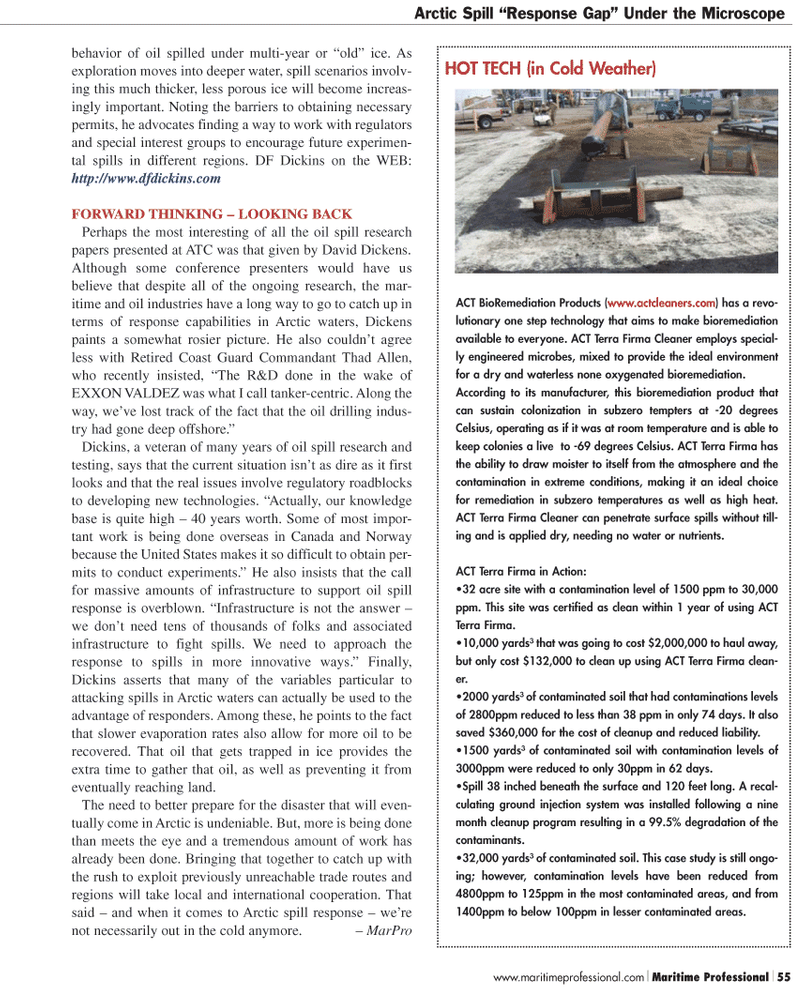
Page 55: of Maritime Logistics Professional Magazine (Q2 2011)
Energy Transportation
Read this page in Pdf, Flash or Html5 edition of Q2 2011 Maritime Logistics Professional Magazine
behavior of oil spilled under multi-year or “old” ice. As exploration moves into deeper water, spill scenarios involv- ing this much thicker, less porous ice will become increas- ingly important. Noting the barriers to obtaining necessary permits, he advocates finding a way to work with regulators and special interest groups to encourage future experimen- tal spills in different regions. DF Dickins on the WEB: http://www.dfdickins.com
FORWARD THINKING – LOOKING BACK
Perhaps the most interesting of all the oil spill research papers presented at ATC was that given by David Dickens.
Although some conference presenters would have us believe that despite all of the ongoing research, the mar- itime and oil industries have a long way to go to catch up in terms of response capabilities in Arctic waters, Dickens paints a somewhat rosier picture. He also couldn’t agree less with Retired Coast Guard Commandant Thad Allen, who recently insisted, “The R&D done in the wake of
EXXON VALDEZ was what I call tanker-centric. Along the way, we’ve lost track of the fact that the oil drilling indus- try had gone deep offshore.”
Dickins, a veteran of many years of oil spill research and testing, says that the current situation isn’t as dire as it first looks and that the real issues involve regulatory roadblocks to developing new technologies. “Actually, our knowledge base is quite high – 40 years worth. Some of most impor- tant work is being done overseas in Canada and Norway because the United States makes it so difficult to obtain per- mits to conduct experiments.” He also insists that the call for massive amounts of infrastructure to support oil spill response is overblown. “Infrastructure is not the answer – we don’t need tens of thousands of folks and associated infrastructure to fight spills. We need to approach the response to spills in more innovative ways.” Finally,
Dickins asserts that many of the variables particular to attacking spills in Arctic waters can actually be used to the advantage of responders. Among these, he points to the fact that slower evaporation rates also allow for more oil to be recovered. That oil that gets trapped in ice provides the extra time to gather that oil, as well as preventing it from eventually reaching land.
The need to better prepare for the disaster that will even- tually come in Arctic is undeniable. But, more is being done than meets the eye and a tremendous amount of work has already been done. Bringing that together to catch up with the rush to exploit previously unreachable trade routes and regions will take local and international cooperation. That said – and when it comes to Arctic spill response – we’re not necessarily out in the cold anymore. – MarPro www.maritimeprofessional.com Maritime Professional 55
Arctic Spill “Response Gap” Under the Microscope
HOT TECH (in Cold Weather)
ACT BioRemediation Products (www.actcleaners.com) has a revo- lutionary one step technology that aims to make bioremediation available to everyone. ACT Terra Firma Cleaner employs special- ly engineered microbes, mixed to provide the ideal environment for a dry and waterless none oxygenated bioremediation.
According to its manufacturer, this bioremediation product that can sustain colonization in subzero tempters at -20 degrees
Celsius, operating as if it was at room temperature and is able to keep colonies a live to -69 degrees Celsius. ACT Terra Firma has the ability to draw moister to itself from the atmosphere and the contamination in extreme conditions, making it an ideal choice for remediation in subzero temperatures as well as high heat.
ACT Terra Firma Cleaner can penetrate surface spills without till- ing and is applied dry, needing no water or nutrients.
ACT Terra Firma in Action: •32 acre site with a contamination level of 1500 ppm to 30,000 ppm. This site was certified as clean within 1 year of using ACT
Terra Firma. •10,000 yards³ that was going to cost $2,000,000 to haul away, but only cost $132,000 to clean up using ACT Terra Firma clean- er. •2000 yards³ of contaminated soil that had contaminations levels of 2800ppm reduced to less than 38 ppm in only 74 days. It also saved $360,000 for the cost of cleanup and reduced liability. •1500 yards³ of contaminated soil with contamination levels of 3000ppm were reduced to only 30ppm in 62 days. •Spill 38 inched beneath the surface and 120 feet long. A recal- culating ground injection system was installed following a nine month cleanup program resulting in a 99.5% degradation of the contaminants. •32,000 yards³ of contaminated soil. This case study is still ongo- ing; however, contamination levels have been reduced from 4800ppm to 125ppm in the most contaminated areas, and from 1400ppm to below 100ppm in lesser contaminated areas.

 54
54

 56
56
